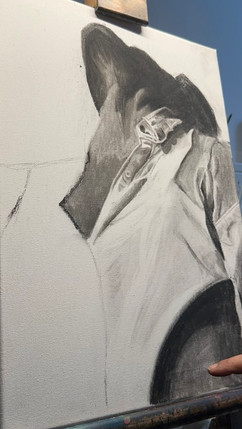My Process of Creating an Abstract Hidden Face
- souravi
- Aug 20
- 2 min read
Introduction
There is something about the fabric and form that has always pulled me in. Unlike a face, which immediately tells you who someone is, clothing creates mystery. It carries presence, without showing identity - a story without a narrator. This piece was an attempt to explore exactly that.
Materials
Here’s what I used for this portrait:
Canvas – A textured canvas works best for me with charcoal because it holds the pigment well and allows for blending.
Charcoal – I used both compressed and willow charcoal to create depth and detail.
Scale Tool – Essential for measuring and maintaining correct proportions.
Eraser – I used a combination of a normal eraser for larger areas and a precise eraser for finer details and highlights.
Blending Tool & Fingers – For blending and softening the shadows without losing detail.
Reference
I began with this captivating pin from Pinterest - https://pin.it/bCMTxyqRx
Nothing too dramatic at first glance, but I was struck by the foreshortening and by how much mood was hidden in the folds and play of light. The anonymity was mysterious.
My Process
1. Sketching the Base
I started with a simple charcoal outline:
Marking the strong diagonal lines of the shirt and collar.
Lightly blocking the shape of the hat.
Leaving the center open, because the drama would come from the shadows later.
At this stage, it looked like just lines, but I could already sense the weight the shadows would bring.
2. Building the Shadows
Since charcoal is an unstable material, I started from the top, slowly working on sections and layers. Charcoal is all about patience. I love playing with it, hence I slowly built the layers:
Beginning with mid-tones with willow charcoal, which is the easiest to lighten with erasers or darken with soft charcoals layers on top of it.
Then I subtracted with the blending tool/ different kinds of erasers to get different values and details for lighter areas.
Then I started applying layers to build up values wherever required.
Then, pressing into the blackest shadows was applied.
Then? - A break of 1 hour at least to chill with my husband and dog baby, or sometimes eat something, only to get back with a fresh perspective.
Add any missing details to it.
3. Adding Details
Details came last:
The stitching along the collar.
The creases of fabric catching light.
Subtle highlights to separate the layers of fabric from the shadows.
I didn’t want to over-polish; the rough edges keep a little rawness intact, as well as keep me away from the disease of "perfectionism".
4. Reflection
When I stepped back, I realized this work was less about fabric and more about identity. By leaving out the face, the figure becomes universal — anyone can project themselves into it. What remains is presence, power, and silence.
Final Thought
This piece reminded me that sometimes absence is its kind of expression. A fold, a shadow, a head held high upwards, and A hidden face — they can speak as loudly as eyes and lips.



























Comments